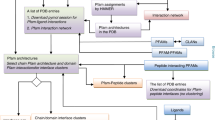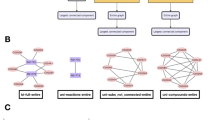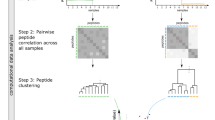Key Points
-
Systems biology aims to develop experimentally-validated quantitative models of complex biochemical pathways. The data needed for this task cannot be generated by 'omics'-type methods alone, but instead require a hypothesis-driven approach that integrates multiple experimental techniques.
-
There are trade-offs to consider when choosing the types of assay to use in a systems biology study because throughput, multiplexing, sample size, sampling density and ease of use cannot all be simultaneously maximized. Experimental studies should be designed to be compatible with the chosen modelling approach.
-
For monitoring protein-signalling events, affinity-based methods, mass-spectrometry and protein-activity assays each have their strengths and weaknesses. Recent advances continue to improve the usefulness of these assays for systems biology.
-
Single-cell measurements are another important element in developing accurate models of biochemical events. Because only few signals can be monitored at the single-cell level, these data are most effective when combined with population-level biochemical assays.
-
Appropriate data validation and normalization techniques are crucial for constructing consistent data sets to inform modelling approaches. Several methods of data scaling can be used to highlight different features of a data set.
Abstract
Systems biology, particularly of mammalian cells, is data starved. However, technologies are now in place to obtain rich data, in a form suitable for model construction and validation, that describes the activities, states and locations of cell-signalling molecules. The key is to use several measurement technologies simultaneously and, recognizing each of their limits, to assemble a self-consistent compendium of systematic data.
This is a preview of subscription content, access via your institution
Access options
Subscribe to this journal
Receive 12 print issues and online access
$189.00 per year
only $15.75 per issue
Buy this article
- Purchase on Springer Link
- Instant access to full article PDF
Prices may be subject to local taxes which are calculated during checkout


Similar content being viewed by others
References
Mockler, T. C. et al. Applications of DNA tiling arrays for whole-genome analysis. Genomics 85, 1–15 (2005).
Fan, J. B., Chee, M. S. & Gunderson, K. L. Highly parallel genomic assays. Nature Rev. Genet. 7, 632–644 (2006).
Joyce, A. R. & Palsson, B. O. The model organism as a system: integrating 'omics' data sets. Nature Rev. Mol. Cell Biol. 7, 198–210 (2006).
Kim, T. H. & Ren, B. Genome-wide analysis of protein–DNA interactions. Annu. Rev. Genomics Hum. Genet. 7, 81–102 (2006).
Ness, S. A. Basic microarray analysis: strategies for successful experiments. Methods Mol. Biol. 316, 13–33 (2006).
Quackenbush, J. Microarray data normalization and transformation. Nature Genet. 32 (Suppl.), 496–501 (2002).
Morris, M. & Watkins, S. M. Focused metabolomic profiling in the drug development process: advances from lipid profiling. Curr. Opin. Chem. Biol. 9, 407–412 (2005).
Nielsen, J. & Oliver, S. The next wave in metabolome analysis. Trends Biotechnol. 23, 544–546 (2005).
Gaudet, S. et al. A compendium of signals and responses triggered by prodeath and prosurvival cytokines. Mol. Cell. Proteomics 4, 1569–1590 (2005). An example of data-compendium assembly from a data set of ∼7,000 heterogeneous protein measurements. Shows the critical importance of appropriate data normalization and scaling techniques in building predictive models.
Sasagawa, S., Ozaki, Y., Fujita, K. & Kuroda, S. Prediction and validation of the distinct dynamics of transient and sustained ERK activation. Nature Cell Biol. 7, 365–373 (2005). A mechanistic modelling effort is driven by an impressive data set of immunoblots and GTPase assays. An excellent example of a model carefully matched to experimental data.
Schweitzer, B. et al. Immunoassays with rolling circle DNA amplification: a versatile platform for ultrasensitive antigen detection. Proc. Natl Acad. Sci. USA 97, 10113–10119 (2000).
Debad, J. D., Glezer, E. N., Wohlstadter, J. N. & Sigal, G. B. in Electrogenerated Chemiluminescence (ed. Bard, A. J.) 43–78 (Marcel Dekker, New York, 2004).
Vignali, D. A. Multiplexed particle-based flow cytometric assays. J. Immunol. Methods 243, 243–255 (2000).
Kortum, R. L. et al. The molecular scaffold kinase suppressor of Ras1 (KSR1) regulates adipogenesis. Mol. Cell. Biol. 25, 7592–7604 (2005).
Haab, B. B. Advances in protein microarray technology for protein expression and interaction profiling. Curr. Opin. Drug Discov. Devel. 4, 116–123 (2001).
MacBeath, G. Protein microarrays and proteomics. Nature Genet. 32 (Suppl.), 526–532 (2002).
Wang, C. C. et al. Array-based multiplexed screening and quantitation of human cytokines and chemokines. J. Proteome Res. 1, 337–343 (2002).
Olle, E. W. et al. Development of an internally controlled antibody microarray. Mol. Cell. Proteomics 4, 1664–1672 (2005).
Jones, R. B., Gordus, A., Krall, J. A. & MacBeath, G. A quantitative protein interaction network for the ErbB receptors using protein microarrays. Nature 439, 168–174 (2006). Protein microarrays were used to measure the synoptic binding profile of all human SH2 and PTB domains for 61 phosphotyrosine sites in the ERBB1–4 receptors.
Ptacek, J. et al. Global analysis of protein phosphorylation in yeast. Nature 438, 679–684 (2005).
Hermann, T. & Patel, D. J. Adaptive recognition by nucleic acid aptamers. Science 287, 820–825 (2000).
Tombelli, S., Minunni, M. & Mascini, M. Analytical applications of aptamers. Biosens. Bioelectron. 20, 2424–2434 (2005).
Harlow, E. & Lane, D. Antibodies: a Laboratory Manual. (Cold Spring Harbor Laboratory Press, Cold Spring Harbor, 1988).
Colby, D. W. et al. Engineering antibody affinity by yeast surface display. Methods Enzymol. 388, 348–358 (2004).
Aebersold, R. & Mann, M. Mass spectrometry-based proteomics. Nature 422, 198–207 (2003).
Ong, S. E. et al. Stable isotope labeling by amino acids in cell culture, SILAC, as a simple and accurate approach to expression proteomics. Mol. Cell. Proteomics 1, 376–386 (2002).
Zieske, L. R. A perspective on the use of iTRAQ reagent technology for protein complex and profiling studies. J. Exp. Bot. 57, 1501–1508 (2006).
Zhang, Y. et al. Time-resolved mass spectrometry of tyrosine phosphorylation sites in the epidermal growth factor receptor signaling network reveals dynamic modules. Mol. Cell. Proteomics 4, 1240–1250 (2005).
Schmelzle, K. & White, F. M. Phosphoproteomic approaches to elucidate cellular signaling networks. Curr. Opin. Biotechnol. 17, 406–414 (2006).
Beausoleil, S. A. et al. Large-scale characterization of HeLa cell nuclear phosphoproteins. Proc. Natl Acad. Sci. USA 101, 12130–12135 (2004).
Moser, K. & White, F. M. Phosphoproteomic analysis of rat liver by high capacity IMAC and LC–MS/MS. J. Proteome Res. 5, 98–104 (2006).
Nousiainen, M., Sillje, H. H., Sauer, G., Nigg, E. A. & Korner, R. Phosphoproteome analysis of the human mitotic spindle. Proc. Natl Acad. Sci. USA 103, 5391–5396 (2006).
Janes, K. A. et al. A high-throughput quantitative multiplex kinase assay for monitoring information flow in signaling networks: application to sepsis-apoptosis. Mol. Cell. Proteomics 2, 463–473 (2003).
Janes, K. A. et al. The response of human epithelial cells to TNF involves an inducible autocrine cascade. Cell 124, 1225–1239 (2006).
Shults, M. D. & Imperiali, B. Versatile fluorescence probes of protein kinase activity. J. Am. Chem. Soc. 125, 14248–14249 (2003).
Shults, M. D., Pearce, D. A. & Imperiali, B. Modular and tunable chemosensor scaffold for divalent zinc. J. Am. Chem. Soc. 125, 10591–10597 (2003).
Shults, M. D., Janes, K. A., Lauffenburger, D. A. & Imperiali, B. A multiplexed homogeneous fluorescence-based assay for protein kinase activity in cell lysates. Nature Methods 2, 277–283 (2005).
Evans, M. J. & Cravatt, B. F. Mechanism-based profiling of enzyme families. Chem. Rev. 106, 3279–3301 (2006).
Jessani, N. et al. Carcinoma and stromal enzyme activity profiles associated with breast tumor growth in vivo. Proc. Natl Acad. Sci. USA 101, 13756–13761 (2004).
Perfetto, S. P., Chattopadhyay, P. K. & Roederer, M. Seventeen-colour flow cytometry: unravelling the immune system. Nature Rev. Immunol. 4, 648–655 (2004).
Ecker, R. C. & Steiner, G. E. Microscopy-based multicolor tissue cytometry at the single-cell level. Cytometry A 59, 182–190 (2004).
Lahav, G. et al. Dynamics of the p53–Mdm2 feedback loop in individual cells. Nature Genet. 36, 147–150 (2004).
Nair, V. D., Yuen, T., Olanow, C. W. & Sealfon, S. C. Early single cell bifurcation of pro- and antiapoptotic states during oxidative stress. J. Biol. Chem. 279, 27494–27501 (2004).
Nelson, D. E. et al. Oscillations in NF-κB signaling control the dynamics of gene expression. Science 306, 704–708 (2004). Live-cell imaging and computational modelling are combined to link pulses of NF-κB nuclear translocation to the level of transcriptional activity.
Eissing, T. et al. Bistability analyses of a caspase activation model for receptor-induced apoptosis. J. Biol. Chem. 279, 36892–36897 (2004).
Geva-Zatorsky, N. et al. Oscillations and variability in the p53 system. Mol. Syst. Biol. 2, 2006.0033 (2006). An intensive effort in which live-cell measurements of p53 and MDM2 translocation dynamics in ∼1,000 single cells are used to constrain mechanistic network models and identify sources of cell-to-cell variability.
Rossi, F. M., Kringstein, A. M., Spicher, A., Guicherit, O. M. & Blau, H. M. Transcriptional control: rheostat converted to on/off switch. Mol. Cell 6, 723–728 (2000).
Tyas, L., Brophy, V. A., Pope, A., Rivett, A. J. & Tavare, J. M. Rapid caspase-3 activation during apoptosis revealed using fluorescence-resonance energy transfer. EMBO Rep. 1, 266–270 (2000).
Krutzik, P. O. & Nolan, G. P. Intracellular phospho-protein staining techniques for flow cytometry: monitoring single cell signaling events. Cytometry A 55, 61–70 (2003).
Sachs, K., Perez, O., Pe'er, D., Lauffenburger, D. A. & Nolan, G. P. Causal protein-signaling networks derived from multiparameter single-cell data. Science 308, 523–529 (2005). A novel method for using flow cytometry data to automatically generate network topology models.
Irish, J. M. et al. Single cell profiling of potentiated phospho-protein networks in cancer cells. Cell 118, 217–228 (2004).
Perlman, Z. E. et al. Multidimensional drug profiling by automated microscopy. Science 306, 1194–1198 (2004).
Soen, Y., Mori, A., Palmer, T. D. & Brown, P. O. Exploring the regulation of human neural precursor cell differentiation using arrays of signaling microenvironments. Mol. Syst. Biol. 2, 37 (2006).
Wu, J. Q. & Pollard, T. D. Counting cytokinesis proteins globally and locally in fission yeast. Science 310, 310–314 (2005). Fluorescence microscopy and flow cytometry of yellow-FP-tagged genes was used to determine the absolute global and local concentrations of ∼40 proteins in the yeast cytokinesis network. This is the largest survey of absolute endogenous-protein concentrations so far.
Newman, J. R. et al. Single-cell proteomic analysis of S. cerevisiae reveals the architecture of biological noise. Nature 441, 840–846 (2006).
Bar-Even, A. et al. Noise in protein expression scales with natural protein abundance. Nature Genet. 38, 636–643 (2006).
Danuser, G. & Waterman-Storer, C. M. Quantitative fluorescent speckle microscopy of cytoskeleton dynamics. Annu. Rev. Biophys. Biomol. Struct. 35, 361–387 (2006).
Ponti, A., Machacek, M., Gupton, S. L., Waterman-Storer, C. M. & Danuser, G. Two distinct actin networks drive the protrusion of migrating cells. Science 305, 1782–1786 (2004). Statistical modelling of high-resolution live-cell microscopy data reveals remarkable kinetic differences between subsets of the actin network in migrating cells.
Sasik, R., Calvo, E. & Corbeil, J. Statistical analysis of high-density oligonucleotide arrays: a multiplicative noise model. Bioinformatics 18, 1633–1640 (2002).
Mashima, T., Naito, M., Fujita, N., Noguchi, K. & Tsuruo, T. Identification of actin as a substrate of ICE and an ICE-like protease and involvement of an ICE-like protease but not ICE in VP-16-induced U937 apoptosis. Biochem. Biophys. Res. Commun. 217, 1185–1192 (1995).
Sreekumar, A. et al. Profiling of cancer cells using protein microarrays: discovery of novel radiation-regulated proteins. Cancer Res. 61, 7585–7593 (2001).
Knezevic, V. et al. Proteomic profiling of the cancer microenvironment by antibody arrays. Proteomics 1, 1271–1278 (2001).
Schweitzer, B. et al. Multiplexed protein profiling on microarrays by rolling-circle amplification. Nature Biotechnol. 20, 359–365 (2002).
Nielsen, U. B., Cardone, M. H., Sinskey, A. J., MacBeath, G. & Sorger, P. K. Profiling receptor tyrosine kinase activation by using Ab microarrays. Proc. Natl Acad. Sci. USA 100, 9330–9335 (2003).
Paweletz, C. P. et al. Reverse phase protein microarrays which capture disease progression show activation of pro-survival pathways at the cancer invasion front. Oncogene 20, 1981–1989 (2001).
Chan, S. M., Ermann, J., Su, L., Fathman, C. G. & Utz, P. J. Protein microarrays for multiplex analysis of signal transduction pathways. Nature Med. 10, 1390–1296 (2004).
Schweitzer, B. et al. Multiplexed protein profiling on microarrays by rolling circle amplification. Nature Biotechnol. 20, 359–365 (2002).
El-Ali, J., Sorger, P. K. & Jenson, K. F. Cells on chips. Nature 442, 403–411 (2006).
Acknowledgements
This work was funded by a systems biology centre grant from the National Institutes of Health.
Author information
Authors and Affiliations
Corresponding author
Ethics declarations
Competing interests
The authors declare no competing financial interests.
Related links
Glossary
- Systematic set
-
A data set in which all data are collected from the same experimental system in such a way that all data can be directly compared, regardless of when measurements were made.
- Signal
-
Any type of biomolecule that transfers information in a signalling network.
- Perturbation
-
Any experimental condition that is applied to a cell that causes a shift in the cell's behaviour away from the basal state. This includes extracellular stimulation by physiological ligands, inhibition of protein activities by small molecule inhibitors, or alterations in protein-expression levels by RNA interference or overexpression.
- Immunoblot
-
Also known as a western blot. Following gel-based separation by mass, charge or both, proteins are transferred to a membrane and probed with target-specific antibodies.
- Enzyme-linked-immunosorbent assay
-
(ELISA). ELISAs involve adsorbing or coupling capture antibodies to a 96-well plate. Following protein capture, a target protein is detected, either directly (if it was labelled in the sample) or indirectly, through a labelled detection antibody.
- Flow cytometry
-
A method in which fluorescence-intensity data are recorded from particles in solution as they flow past a detector.
- Protein profiling
-
A method that assesses the expression level of a large set of proteins in a specific tissue or cell type. It is analogous to transcriptional profiling by DNA microarrays.
- Protein-interaction microarray
-
A protein microarray that is used to assay protein interactions. In such arrays, the capture reagents are purified proteins or protein domains, and the analyte solution contains a potential binding partner. Detection strategies are the same as in antibody microarrays (direct labelling or sandwich).
- Substrate-protein microarray
-
A protein microarray that is used to identify substrates of enzymes, such as kinases. In this format, the array consists of potential substrates, and the analyte contains a purified enzyme. Modification of the substrates on the array (for example, phosphorylation) by the analyte is detected by radiolabel incorporation or other labelling strategies.
- Microfluidic device
-
A device for fluid handling in which the smallest dimensions of the features (channels, valves and so on) are on the scale of a few to a few hundred micrometers.
- Stable-isotope labelling with amino acids in culture
-
(SILAC). This method labels proteins from different samples with heavy atoms, yielding mass differences of several Daltons between the same peptide from different samples.
- Isobaric tags for relative and absolute quantification
-
(iTRAQ). iTRAQ labels are initially isobaric, ensuring that the same peptides from different samples behave identically in the full mass spectrum (MS) mode, but they fragment to generate marker ions that differ by a single Dalton in tandem MS mode during peptide identification.
- Marker ion
-
An ion that carries the isotope label in the breakdown of a peptide during tandem mass spectrometry analysis.
- Chemosensor
-
In the context of kinase assays, a chemosensor is a substrate peptide that contains the non-natural amino acid Sox, which displays chelation-enhanced fluorescence when the peptide is phosphorylated.
- Activity-based protein profiling
-
(ABPP). A method that uses reactive probes carrying a label that will covalently bind specifically to active enzymes of a certain class. The label is often a fluorophore, enabling visualization and quantification of coupled enzymes on gels, antibody microarrays or in cells. Recently, reactive probes have been labelled with an affinity tag for capture of the coupled enzymes, quantification and identification by mass spectrometry.
- Image cytometry
-
A method that uses microscope optics to collect low-resolution data from cells that are adhered to a slide.
- Bayesian network inference
-
A statistical method for inferring the probable relationships between measured variables.
- Data validation
-
The process of verifying assay accuracy.
- Data normalization
-
The adjustment of measured values to account for possible run-to-run and day-to-day variability in the assays.
- Fluorescence speckle microscopy
-
Speckles that form by the random association of fluorophores with macromolecular structures are tracked by live-cell imaging. The information in the dynamic behaviour of these speckles is converted into a quantitative spatio-temporal readout of cytoskeleton-polymer transport and turnover.
- Orthogonal design
-
A method of validation in which conditions that were previously varied from experiment to experiment in the course of collecting a full data set are varied in a single experiment such that what was previously separated in time now becomes contemporaneous.
Rights and permissions
About this article
Cite this article
Albeck, J., MacBeath, G., White, F. et al. Collecting and organizing systematic sets of protein data. Nat Rev Mol Cell Biol 7, 803–812 (2006). https://doi.org/10.1038/nrm2042
Issue Date:
DOI: https://doi.org/10.1038/nrm2042
This article is cited by
-
Robust latent-variable interpretation of in vivo regression models by nested resampling
Scientific Reports (2019)
-
An ultrasensitive fiveplex activity assay for cellular kinases
Scientific Reports (2019)
-
Data-Modeling Identifies Conflicting Signaling Axes Governing Myoblast Proliferation and Differentiation Responses to Diverse Ligand Stimuli
Cellular and Molecular Bioengineering (2017)
-
From computational modelling of the intrinsic apoptosis pathway to a systems-based analysis of chemotherapy resistance: achievements, perspectives and challenges in systems medicine
Cell Death & Disease (2014)
-
Creating and analyzing pathway and protein interaction compendia for modelling signal transduction networks
BMC Systems Biology (2012)



